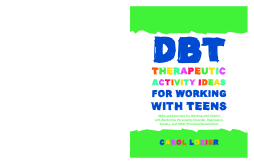
Additional Information
Book Details
Abstract
This fun and engaging activity book helps to teach teens to manage emotions and develop relationships by tracking their progress using Dialectical Behaviour Therapy (DBT) techniques. DBT is specifically designed for emotionally sensitive young people, especially those with borderline personality disorder, and the activities in this book will help regulate strong emotional responses which can lead to impulsivity, unstable relationships, low self-image and reactive emotions.
It is a concise and easy-to-read resource, accompanied by vignettes and activity sheets. It presents an overview of the four modules of DBT: mindfulness, distress tolerance, emotional regulation, and interpersonal effectiveness. These skills used in these modules can be logged and monitored through the tick lists and diary cards provided. These practical tools and ideas are reproducible, and will be invaluable for anyone working with teens.
A wonderful and important addition to the Dialectical Behavioural Therapy world; with numerous fun and clear doodles, activities, and photocopiable worksheets included throughout. This book is written for teenagers, and manages to be engaging and accessible in style; whilst also covering all of the key DBT concepts- from mindfulness, to distress tolerance, to emotional regulation, to interpersonal effectiveness. A useful book for any therapist's shelf.
Dr Karen Treisman, Specialist Clinical Psychologist, Trainer, and Author of several books including a Therapeutic Treasure Box for Working with Developmental Trauma
Both charming and practical in design, this resource includes engaging and relatable vignettes, individualized homework sheets, and teaching notes for clinicians and instructors. These help facilitate our young clients' deepened understanding of DBT, as well as their ability to effectively apply what they learn to real-life situations.
Susan M. Clark, author of DBT-Informed Art Therapy: Mindfulness, Cognitive Behavior Therapy, and the Creative Process
This book is a wonderful addition to the library of any DBT skills trainer. It can be hard to understand how to implement DBT skills into practice for beginning clinicians. In this book, Lozier has distilled the principles of DBT into an easy-to-read book for clinicians with simplified worksheets for clinicians working with children and adolescents.
Aditi Vijay, Ph.D., Assistant Professor, Georgetown University
Carol Lozier is a US clinical social worker with over 20 years' experience, and author of books on attachment and adoption. She is based in Louisville, Kentucky.
Table of Contents
| Section Title | Page | Action | Price |
|---|---|---|---|
| DBT Therapeutic Activities for Teens by Carol Lozier | 9 | ||
| Introduction | 9 | ||
| The Adolescent | 10 | ||
| DBT Skills Trainers | 10 | ||
| Introducing DBT to Teens and Families | 11 | ||
| The Activity Book | 11 | ||
| Section 1: What is DBT? | 13 | ||
| 1. What is Dialectical Behavior Therapy (DBT)? | 13 | ||
| 2. Biosocial Theory | 21 | ||
| 3. The “D” in DBT | 24 | ||
| 4. DBT Acronyms | 27 | ||
| 5. DBT is a Lifestyle | 31 | ||
| 6. Logs (Diary Cards) | 35 | ||
| 7. Lists, Information, and Suggestions | 39 | ||
| Section 2: Mindfulness | 55 | ||
| 1. What is Mindfulness (MI)? | 55 | ||
| 2. WHAT Skills | 57 | ||
| 3. HOW Skills | 59 | ||
| 4. Mindfulness Activities | 61 | ||
| 5. Grounding Techniques | 67 | ||
| 6. Coloring Sheets | 70 | ||
| 7. Three States of Mind | 73 | ||
| Section 3: Distress Tolerance | 75 | ||
| 1. What is Distress Tolerance (DT)? | 75 | ||
| 2. Crisis Survival Skills: Self-Soothing | 78 | ||
| 3. Crisis Survival Skills: Wise Mind ACCEPTS | 81 | ||
| 4. Crisis Survival Skills: IMPROVE the Moment | 87 | ||
| 5. Crisis Survival Skills: The STOP Skill | 92 | ||
| 6. Crisis Survival Skills: TIP Skills | 96 | ||
| 7. Crisis Survival Skills: Pros and Cons | 99 | ||
| 8. Reality Acceptance Skills: Willingness vs. Willfulness | 103 | ||
| 9. Reality Acceptance Skills: Turning the Mind | 110 | ||
| 10. Reality Acceptance Skills: Radical Acceptance | 117 | ||
| 11. Reality Acceptance Skills: Half-Smiling | 127 | ||
| Section 4: Emotion Regulation | 129 | ||
| 1. What is Emotion Regulation (ER)? | 129 | ||
| 2. Exploring and Knowing My Emotions | 132 | ||
| 3. ABC | 136 | ||
| 4. Surfing the Wave | 142 | ||
| 5. Opposite Action | 147 | ||
| 6. PLEASE | 155 | ||
| 7. Lemonade | 161 | ||
| Section 5: Interpersonal Effectiveness | 165 | ||
| 1. What is Interpersonal Effectiveness (IE)? | 165 | ||
| 2. Repairs | 167 | ||
| 3. TAPS | 172 | ||
| 4. THINK | 177 | ||
| 5. The Four Horsemen | 183 | ||
| 6. GIVE | 189 | ||
| 7. FAST | 194 | ||
| References | 199 | ||
| Blank Page |
